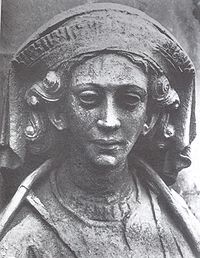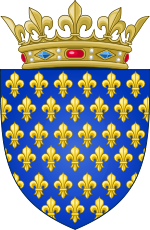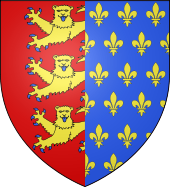- Margaret of France, Queen of England
-
For other people of the same name, see Margaret of France (disambiguation).
Margaret of France 
Queen consort of England Tenure 8 September 1299 – 7 July 1307 Spouse Edward I of England Issue Thomas of Brotherton, 1st Earl of Norfolk
Edmund of Woodstock, 1st Earl of KentHouse Capetian Dynasty
House of PlantagenetFather Philip III of France Mother Maria of Brabant Born 1279 ?
Paris, FranceDied 14 February 1318
Marlborough Castle, WiltshireBurial Christ Church Greyfriars, Newgate Margaret of France (1279 ?[1] – 14 February 1318[1]), a daughter of Philip III of France and Maria of Brabant, was Queen of England as the second wife of King Edward I, who was her father's first cousin.
Contents
Early life
Her father died when she was only three years old and she grew up under guidance of her mother and Joan I of Navarre, her half-brother King Philip IV's wife.[2]
Marriage
Three years after the death of his beloved first wife, Eleanor of Castile, at the age of 49 in 1290, Edward I was still grieving. But Edward decided that he would marry Blanche of France at any cost and sent out emissaries to negotiate the marriage with her half-brother, King Philip. It was much to Edward's benefit to make peace with France to free him to pursue his wars in Scotland. Philip agreed to give Blanche to Edward on the following conditions:
- A truce was concluded between the two countries.
- Edward gave up the province of Gascony.
Edward agreed and sent his brother Edmund Crouchback, Earl of Lancaster, to fetch the new bride. Edward had been deceived, for Blanche was to be married to Rudolph III of Habsburg, the eldest son of King Albert I of Germany. Instead, Philip offered her younger sister Margaret, a young girl of 11, to marry Edward (then 55). Upon hearing this, Edward declared war on France, refusing to marry Margaret. After five years, a truce was agreed, under the terms of which Edward would marry Margaret, would regain the key city of Guienne, and receive £15,000 owed to Margaret.
Edward was then 60 years old. The wedding took place at Canterbury on 8 September 1299. Margaret was never crowned, being the first uncrowned queen since the Conquest.[4]
French Monarchy Direct Capetians 
Philip III Philip IV Charles III, Count of Valois Louis d'Evreux Margaret, Queen of England Blanche, Duchess of Austria Edward soon returned to the Scottish border to continue his campaigns and left Margaret in London, but she had become pregnant quickly after the wedding. After several months, bored and lonely, the young queen decided to join her husband. Nothing could have pleased the king more, for Margaret's actions reminded him of his first wife Eleanor, who had had two of her sixteen children abroad.
In less than a year Margaret gave birth to a son, Thomas of Brotherton who was named after Thomas Becket, since she had prayed to him during her pregnancy. That Margaret was physically fit was demonstrated by the fact that she was still hunting when her labour pains started.[5]
The next year she gave birth to another son, Edmund.
It is said[who?] that many who fell under the king's wrath were saved from too stern a punishment by the queen's influence over her husband, and the statement, Pardoned solely on the intercession of our dearest consort, queen Margaret of England, appears.
She favored the Franciscan order and was a benefactress of a new foundation at Newgate. Margaret employed the minstrel Guy de Psaltery and both she and her husband liked to play chess.[6]
Margaret soon became firm friends with her stepdaughter Mary of Woodstock, a nun, who was two years older than the young queen. She and her stepson, Edward, Prince of Wales, the future king Edward II (who was two years younger than her), also became fond of each other: he once made her a gift of an expensive ruby and gold ring, and she on one occasion rescued many of the Prince's friends from the wrath of the King.
The mismatched couple were blissfully happy. When Blanche died in 1305 (her husband never became Emperor), Edward ordered all the court to go into mourning to please his queen. He had realised the wife he had gained was "a pearl of great price". The same year Margaret gave birth to a girl, Eleanor, named in honour of Edward's first queen, a choice of which surprised many, and showed Margaret's unjealous nature.
When Edward went on summer campaign to Scotland in 1307, Margaret accompanied him, but he died in Burgh by Sands.
Queen Dowager
Margaret was not pleased when Edward II made Piers Gaveston Earl of Cornwall upon his father's death, since the title had been meant for her own son.[7] She attended his wedding to her half-niece, Isabella of France, and a silver casket was made with both their arms. Margaret retired to her castle in Marlborough after her coronation, but she stayed in touch with Isabella and her half-brother Philip by letter during the confusing times leading up to Gaveston's death.
She assisted at the birth of prince Edward.
In 1318, she died in her castle at Marlborough.
Issue
In all, Margaret gave birth to three children:
- Thomas of Brotherton, 1st Earl of Norfolk (1300–1338)
- Edmund of Woodstock, 1st Earl of Kent (1301–1330)
- Eleanor of England (4 May 1306 - 1311)
Ancestry
Ancestors of Marguerite of FranceLater life
She never remarried after Edward's death in 1307, despite being only 26 when widowed. She lived out the remainder of her life in Marlborough Castle, by this time a dower house, and used her immense dowry to relieve people's suffering. Her saying was, "when Edward died, all men died for me". She died just 10 years after her husband, at the age of 36, and was buried at Greyfriar's Church, Newgate.
Notes and references
- ^ a b John Carmi Parsons, ‘Margaret (1279?–1318)’, Oxford Dictionary of National Biography, Oxford University Press, Sept 2004; online edn, Jan 2008.
- ^ Hilton, Lisa (2008). Queens Consort, England's Medieval Queens. Great Britain: Weidenfeld & Nichelson. p. 238. ISBN 978-0-7538-2611-9.
- ^ Boutell, Charles (1863), A Manual of Heraldry, Historical and Popular, London: Winsor & Newton, pp. 275
- ^ Williamson, D. (1986), Kings and Queens of Britain, p. 75, Salem House, ISBN 0-88162-213-3.
- ^ Hilton, Lisa (2008). p. 240.
- ^ Hilton, Lisa (2008). p. 241.
- ^ Hilton, Lisa (2008). p. 247.
English royalty Vacant Title last held byEleanor of CastileQueen consort of England
Lady of Ireland
8 September 1299 – 7 July 1307Vacant Title next held byIsabella of FranceEnglish Royal Consorts Matilda of Flanders (1066–1083) · Matilda of Scotland (1100–1118) · Adeliza of Louvain (1121–1135) · Matilda I of Boulogne (1135–1152) · (Geoffrey V of Anjou?) (1141) · Eleanor of Aquitaine (1154–1189) · Margaret of France (1172–1183) · Berengaria of Navarre (1191–1199) · Isabella of Angoulême (1200–1216) · Eleanor of Provence (1236–1272) · Eleanor of Castile (1272–1290) · Margaret of France (1299–1307) · Isabella of France (1308–1327) · Philippa of Hainault (1328–1369) · Anne of Bohemia (1383–1394) · Isabella of Valois (1396–1399) · Joanna of Navarre (1403–1413) · Catherine of Valois (1420–1422) · Margaret of Anjou (1445–1471) · Elizabeth Woodville (1464–1483) · Anne Neville (1483–1485) · Elizabeth of York (1486–1503) · Catherine of Aragon (1509–1533) · Anne Boleyn (1533–1536) · Jane Seymour (1536–1537) · Anne of Cleves (1540) · Catherine Howard (1540–1542) · Catherine Parr (1543–1547) · (Lord Guilford Dudley?) (1553) · Anne of Denmark (1603–1619) · Henrietta Maria of France (1625–1649) · Catherine of Braganza (1662–1685) · Mary of Modena (1685–1688) · George of Denmark (1702–1707)Categories:- English royal consorts
- Year of birth uncertain
- 1318 deaths
- French princesses
- House of Capet
- Irish royal consorts
- Medieval women
- Duchesses of Aquitaine
- 13th-century French people
- 14th-century French people
- 13th-century English people
- 14th-century English people
- 13th-century women
- 14th-century women
Wikimedia Foundation. 2010.

